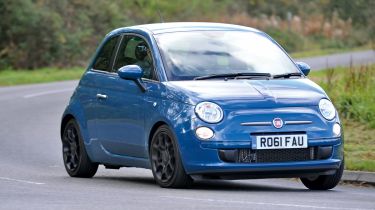Fiat 500 TwinAir
TwinAir engine adds excellent efficiency to cool retro package
The epitome of city car chic, the modern Fiat 500 has successfully recaptured the classless style of the fifties original. Four years after launch, it’s as fashionable as ever.
The unashamedly retro car has taken inspiration from the past for its engine, too. Just like its 50-year-old predecessor, this 500 has a two-cylinder engine – but thankfully the TwinAir is far removed from the original’s spluttering 13bhp motor.
Designed to offer a tantalising have-your-cake-and-eat-it mix of performance and low emissions, it uses a turbocharger and Fiat’s clever electro-hydraulic variable valve timing to produce 85bhp and an impressive 145Nm of torque from only 875cc. Yet it claims fuel economy of 68.9mpg and emissions of only 95g/km.
Sit in the 500 and the retro theme continues. Even the most unsentimental drivers will get some feel-good factor from the silver-effect dash and chrome-ringed buttons. Another nice touch is the instrument pod, which places the speedometer around an outer ring, the rev counter in the inner circle and a digital trip meter in the middle.
It’s a shame that the driver’s seat isn’t height-adjustable, as this leaves taller drivers a bit cramped. Plus, if you look low down in the cabin, the cheap plastics and limited storage space take the edge off the experience.
Used - available now

2021 Audi
A6
28,288 milesAutomaticPetrol2.0L
Cash £27,400
2022 Vauxhall
Corsa
10,873 milesAutomaticPetrol1.2L
Cash £14,700
2025 BMW
i4
19,952 milesAutomaticElectric
Cash £31,000
2024 SEAT
Ibiza
28,777 milesAutomaticPetrol1.0L
Cash £14,500However, fire the engine and the car’s cheeky character instantly comes flooding back. The offbeat idle and thrumming engine note may not suit all tastes, but it only takes a little imagination to picture yourself burbling along in an original rear-engined 500.
The TwinAir spins rapidly and eagerly up to its 6,000rpm red line, delivering surprisingly spirited acceleration. This means the Fiat rarely struggles to keep up in fast-moving traffic.
The healthy 145Nm torque output peaks at just 1,900rpm, so even when cruising, you can press the throttle and feel speed picking up without changing down. This is not something you can do in the 500’s sluggish rivals.
Unsurprisingly, the car had a decisive performance advantage at the test track. It covered the 0-60mph dash in a brisk 11.8 seconds, but it’s the mid-range pace that impresses. The Fiat
went from 50-70mph in 14.1 seconds – a full 4.9 seconds faster than the Picanto and a massive 7.4 seconds up on the underpowered Ford.
Around town, the lumpy idle means you need to give it some revs to move off smoothly, and the stop-start system isn’t as fast as the Kia’s. But with a tight turning circle, it has the nimble reactions you need in cities.
The 500 changes direction keenly and feels stable at speed. The ride is a little firm, but never too bad. There’s more road noise than in the Kia, and it has the smallest boot of the trio. But what it lacks in practicality, the Fiat makes up for with character.
Details
Chart position: 2
WHY: The style benchmark against which all image-conscious small cars are measured. The Fiat is one of the finest city runabouts.







